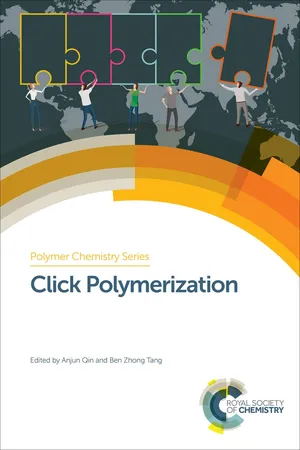
- 248 pages
- English
- ePUB (mobile friendly)
- Available on iOS & Android
Click Polymerization
About This Book
Click chemistry describes organic reactions which are highly efficient, regioselective and allow for mild reaction conditions. The archetypal click reaction of Cu(I)-catalyzed azide-alkyne cycloaddition (CuAAC) is used in many diverse areas and has been extensively developed for polymer synthesis, leading to the term of click polymerization. This technique enables the preparation of functional polymers with linear and topological structures that have the potential to be used in optoelectronics and biological fields.
Edited by world renowned experts, Click Polymerization is the first book to comprehensively summarize this approach to polymer synthesis consolidating all the different reaction types in one resource. From the basic knowledge through to the latest developments in synthesis, chapters include transition-metal catalysed and metal-free azide-alkyne click polymerizations as well as thiol-ene, thiol-yne and thiol-epoxy click polymerizations.
The book provides an authoritative guide to click polymerization techniques for graduate students and researchers interested in polymer chemistry and materials science.
Frequently asked questions
Information
*E-mail: [email protected]; [email protected]
Click polymerizations with remarkable advantages have been nurtured into powerful polymerization techniques with widespread applications. In this overview, several types of click polymerizations and their applications are briefly summarized. Of these, azide–alkyne click polymerizations (AACPs) are the most widely used due to the easy availability of the monomers and the stability of the products. AACPs catalyzed by Cu(I) and Ru(II) can offer 1,4- and 1,5-regioregular PTAs, respectively. Meanwhile, 1,4-regioregular PTAs can also be obtained via metal-free click polymerizations of activated alkynes and azides or activated azides and alkynes. 1,5-regioregular PTAs can be produced by organic base-mediated AACP. Thiol-ene click polymerizations are versatile tools for the preparation of polythioethers with linear and hyperbranched structures. Similarly, thiol-yne click polymerizations, as the updated version of the former, can provide polythioethers and poly (vinyl sulfide)s (PVSs) with diverse structures. Novel reversible polymers can be yielded via Diels–Alder click polymerizations. Some new click polymerizations have also been researched for the synthesis of functional polymers with various structures. With these efficient polymerization techniques in hand, polymer scientists have prepared a large number of polymers with unique properties, such as luminescence, photonic patterning, adjustable light refractivity, optical nonlinearity, biodegradability, catalyst activity, self-assembly and self-healing.
1.1Introduction
Table of contents
- Cover
- Half Title
- Copyright
- Contents
- Title
- Preface
- Chapter 1 Overview of Click Polymerization
- Chapter 2 Transition Metal-catalyzed Click Polymerization
- Chapter 3 Metal-free Azide–Alkyne Click Polymerization
- Chapter 4 Catalyst-free Click Polymerization Using Nitrile N-Oxides Applicable to Various Dipolarophiles
- Chapter 5 Thiol-yne Click Polymerization
- Chapter 6 Thiol-epoxy and Amine-epoxy ‘Click’ Polymerizations
- Chapter 7 Multicomponent Polymerization Mediated by Click Chemistry
- Subject Index